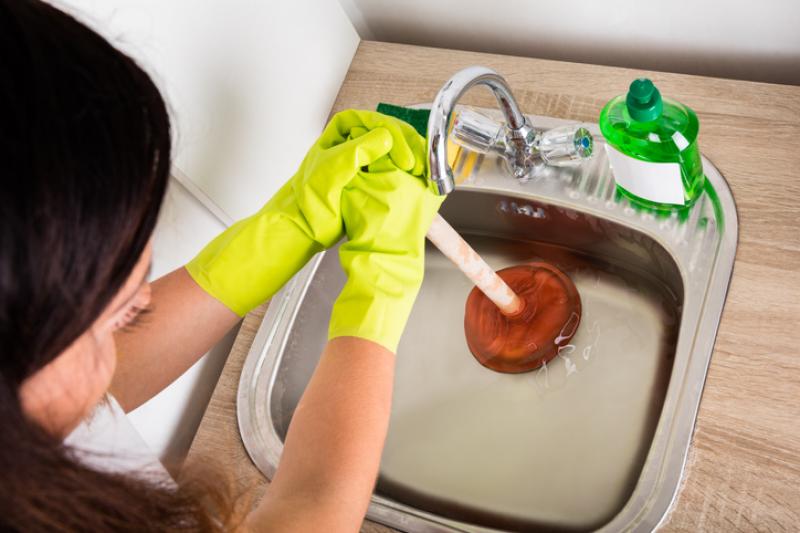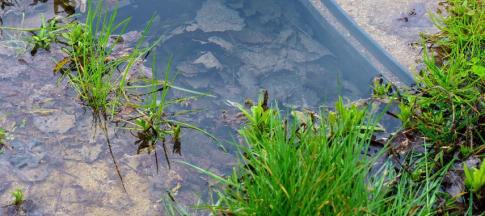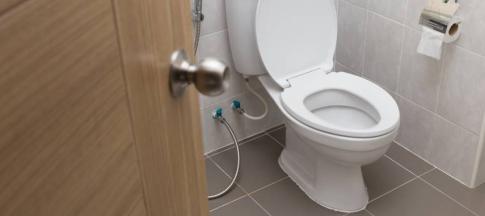
Blockages in your plumbing can be frustrating, but it is possible to fix them yourself.
Here’s everything you need to know about unblocking a sink.
How to unblock a sink with a plunger
A plunger or sink unblocker (sometimes known as a blast or blaster cup) should work for most small blockages.
- Place the suction part over the plughole.
- Use a wet cloth to block the overflow and create an airtight seal.
- Pump the plunger up and down, keeping the cloth in place so the seal doesn’t break.
- After pumping a few times, run some water to see if the sink’s draining properly.
- If not, repeat these steps.
It may take a few times to work.
How to unblock a sink without a plunger
If the plunger doesn’t work, there are a few other methods you can try.
Unblocking a sink with baking soda and vinegar
Using baking soda and white vinegar is good for fizzing limescale away and is a good alternative to using harsh chemicals.
- Pour a teaspoon of soda down the plug.
- Pour a cup of white vinegar down the plug.
- After a few minutes, flush the sink through with warm water.
Unblocking a sink with soda crystals
Soda crystals can also help unblock sinks. They’re particularly good for removing soap residue and grime.
- Dissolve half a packet of soda crystals with boiling water in a jug.
- Pour the mixture down the plughole.
- Wait a minute or so then rinse to see if the water’s draining properly.
Always refer to soda crystal instructions.
Unblocking a sink with an auger/plumber’s snake
For tougher blockages, try an auger or a plumbing snake. This is a long flexible tool which can be pushed around the U-bend.
The screw-tip at the end of the auger may be able to puncture and break up the blockage. The tip may also be able to bring up the material if you can get it back through the plughole.
Once you’ve broken up the blockage, retract the snake and flush through with cold water.
Unblocking a sink with drain cleaner
Sometimes you need to use stronger chemicals.
- Before you start, make sure the room is well ventilated. Keep a window open until it’s done.
- Follow the drain cleaner’s instructions. The first step will usually be to empty either half or the whole bottle down the plughole.
- Wait for the specified amount of time.
- Rinse through with warm water.
Cleaning the U-bend
If none of these other measures work, you may need to remove the U-bend. You’ll need a bucket or washing-up bowl, an old towel, and some rubber gloves.
- Turn off the water supply before you start. The main stopcock can usually be found beneath the kitchen sink.
- Find the first bend under the sink (sometimes called the ‘trap’).
- Lay down the old towel and position a bucket underneath the U-bend. This is to catch any water which spills out.
- Unscrew the fitting where the U-bend connects to the bottom of the sink.
- When water starts to drip out, stop unscrewing and let it drain.
- Once it’s fully drained, remove the U-bend by unscrewing both ends.
- Have a look inside to see if anything’s clogging it and clean it out fully.
If this doesn’t work, you may need to call a plumber.
How to unblock a bathroom sink
Remove any debris first, then try to unblock the sink by using:
- baking soda and white vinegar or soda crystals
- a plunger
- a plumber’s snake
- chemical drain cleaner
Try baking soda or white vinegar first, and then move down the list if it doesn’t work.
Depending on your plumbing, it may be tricky to remove the U-bend, especially if the issue is with the bath.
You can find out how to unblock a toilet here.
How to avoid blocked sinks
Usually, blockages are caused by scraps of food, fat and oils, hair, soap scum and other foreign objects.
While it’s not always possible to stop things going down the plughole, there are steps you can take to avoid too much residue:
- buy a strainer or drain protector - these are usually only around £5 to buy, and you can also use them in the shower or bath to catch hair
- avoid letting food and organic waste go down the sink – organic waste can accumulate and block the sink over time, so it’s always best to use a compost bin instead
- dispose of oil and fat properly – oil, fat and grease can solidify in the pipes (and can catch and trap other food waste) so it’s best to let it cool and harden before disposing of it in the compost
Can bleach unblock a sink?
Bleach isn’t recommended for unblocking sinks.
While it’s an effective disinfectant and good for killing bacteria, it’s not designed to dissolve or break down the types of materials that typically cause sink blockages.
When to call a plumber
If you’ve tried all the methods above but haven’t fixed the problem, call a plumber. To guarantee you’re getting a trusted tradesperson, use a service like Checkatrade.
Home Emergency or Home Emergency Extra cover will cover a call-out to your home if you have an emergency that causes total failure, like blocked or leaking:
- sinks
- rainwater drains
- baths, toilets and external drainage
- soil vent pipes
If you’re a home emergency customer, you can claim by visiting MyAccount or our make a claim page. As a reminder, we can only cover for incidents that:
- are reported within 48 hours
- are up to £500 (Home Emergency cover) or £1,000 (Home Emergency Extra cover) to temporarily repair
- have leaks that can’t be contained
- are a total failure, meaning a complete or continuous loss of service
This can be bought as an add-on to your home insurance, and Home Emergency Extra cover comes as standard with our Platinum cover.
Home Emergency and Home Emergency Extra cover don’t cover general household repairs. The cost of fixing damage caused by the emergency is usually covered by your home insurance.
Other plumbing emergencies
If you have other plumbing issues in your home, you may be able to resolve them yourself.
Read our guides on how to unblock your drain or how to unblock a toilet.


